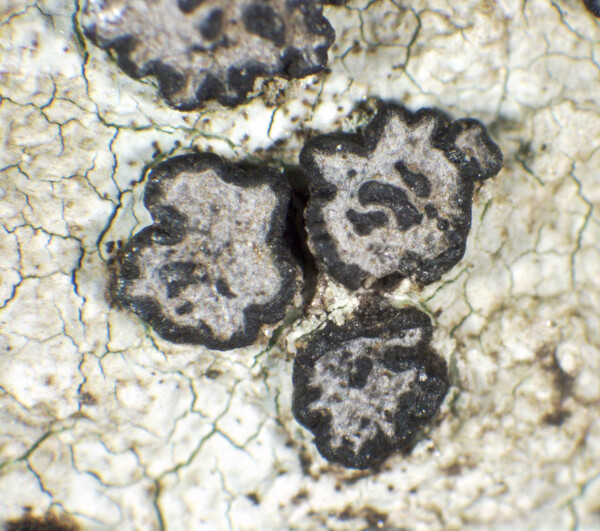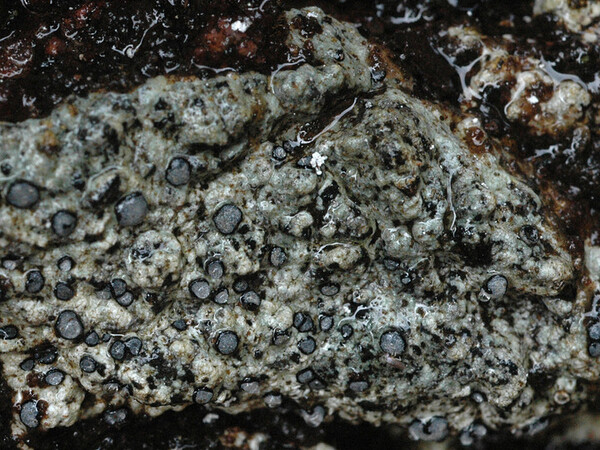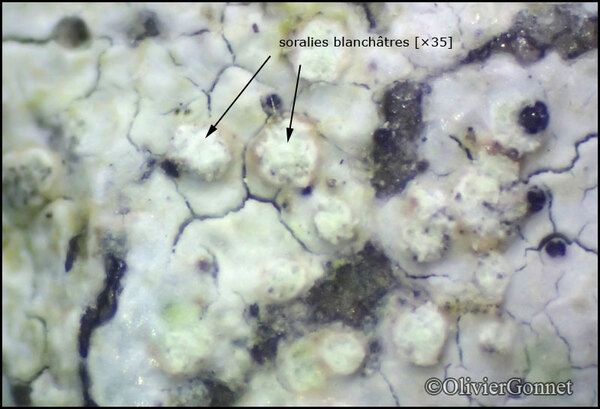Porpidia rugosa (Taylor) Coppins & Fryday
in Fryday, Lichenologist, 37: 29, 2005. Basionym: Endocarpon rugosum Taylor - Fl. Hibern., 2: 258, 1836.
Synonyms: Haplocarpon glaucophaeum (Körb.) V. Wirth; Huilia glaucophaea (Körb.) Hertel; Lecidea albocoerulescens var. alpina Schaer.; Lecidea albuginosa Nyl.; Lecidea glaucophaea Körb.; Lecidea phaeenterodes Nyl.; Lecidea soredizoides (Nyl.) Vain. non (Lamy) Sandst.; Porpidia glaucophaea (Körb.) Hertel & Knoph
Distribution: N - TAA (Nascimbene & al. 2007b, 2022, Jabłońska 2009), Lomb, Emil (Tretiach & al. 2008, Fariselli & al. 2020). C - Tosc (Tretiach & al. 2008), Sar (Neuwirth 2018).
Description: Thallus crustose, episubstratic, continuous to rimose-verruculose, very well-developed, thick, forming large patches, white-grey to cream-coloured, usually sorediate, often delimited by a black prothallus, the soralia - when developed - irregular in outline, often formed along cracks, whitish to grey-white, the soredia coarsely granular to almost digitiform. Medulla white, I-. Apothecia rather frequent also in sorediate forms, lecideine, at first semi-immersed, then sessile and constricted at base, black, 0.8-2(-2.5) mm across, with a flat to moderately convex, densely pruinose disc and a thick, raised, usually epruinose, often flexuose proper margin. Proper exciple dark in outer part, colourless within, the hyphae 2-4 μm thick; epithecium olive-brown; hymenium colourless, 150-190 μm high; paraphyses coherent, branched and anastomosing, slightly swollen at tips; hypothecium dark brown. Asci 8-spored, elongate-clavate, with a thin, outer amyloid layer and a thickened tholus penetrated by a pore, the sides of which are strongly amyloid, Porpidia-type. Ascospores 1-celled, hyaline, ellipsoid, (15-)17-25(-28) x (5-)7-10(-12) μm. Photobiont chlorococcoid. Spot tests: cortex and soralia K-, C-, KC-, P-. Chemistry: without lichen substances, or with glaucophaeic acid, 2'-O-methylsuperphyllinic acid, very rarely with confluentic acid and methy-2-O-methylmicrophyllinate.Note: a mainly mild-temperate species found on siliceous, often metamorphic rocks in sheltered situations, such as in forests and deep gorges, along rivers and creeks, or on pebbles on moist ground.
Growth form: Crustose
Substrata: rocks
Photobiont: green algae other than Trentepohlia
Reproductive strategy: mainly asexual, by soredia, or soredia-like structures (e.g. blastidia)
Commonnes-rarity: (info)
Alpine belt: absent
Subalpine belt: extremely rare
Oromediterranean belt: absent
Montane belt: very rare
Submediterranean belt: extremely rare
Padanian area: absent
Humid submediterranean belt: absent
Humid mediterranean belt: absent
Dry mediterranean belt: absent

Predictive model
Herbarium samples
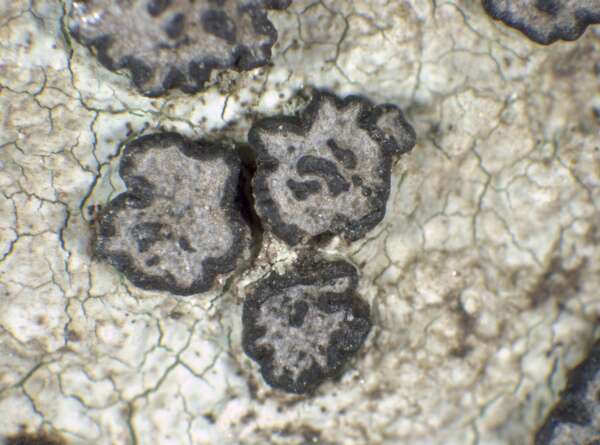

P.L. Nimis; Owner: Department of Life Sciences, University of Trieste
Herbarium: TSB (34941)
2002/04/03
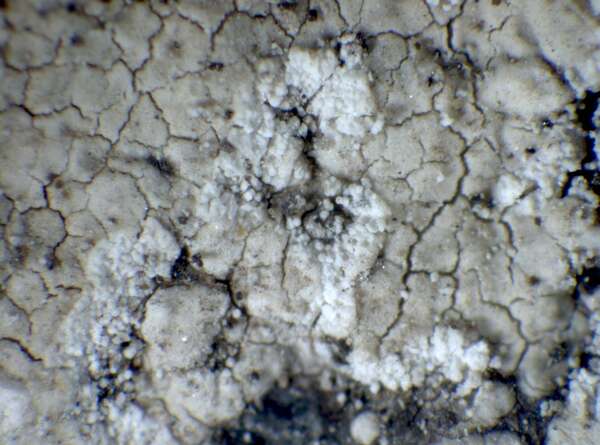

P.L. Nimis; Owner: Department of Life Sciences, University of Trieste
Herbarium: TSB (12258)
2001/11/29
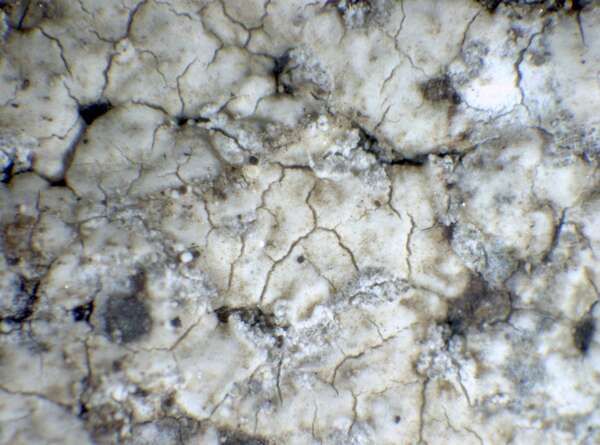

P.L. Nimis; Owner: Department of Life Sciences, University of Trieste
Herbarium: TSB (12258)
2001/11/29
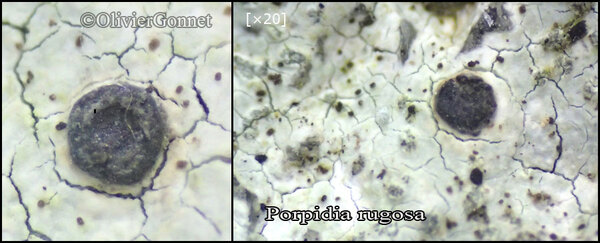
Courtesy Danièle et Olivier Gonnet - Source: https://www.afl-lichenologie.fr/Photos_AFL/Photos_AFL_P/Text_P_5/Porpidia_rugosa.htm
France, 8/7/2015 - Roussillon-en-Morvan - Saône-et-Loire - (71) - Gorges de la Canche, alt. 560 m, sur rochers suintants ombragés
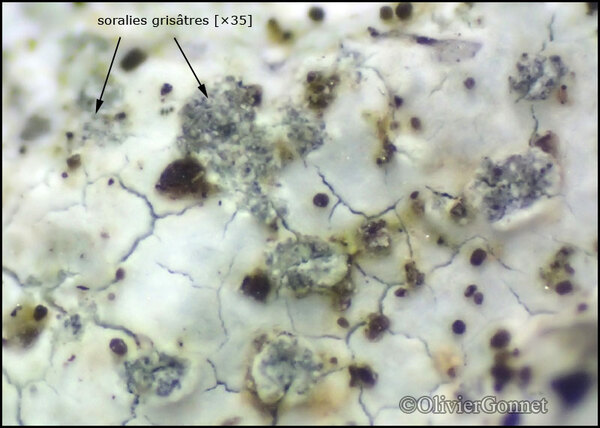
Courtesy Danièle et Olivier Gonnet - Source: https://www.afl-lichenologie.fr/Photos_AFL/Photos_AFL_P/Text_P_5/Porpidia_rugosa.htm
France, 8/7/2015 - Roussillon-en-Morvan - Saône-et-Loire - (71) - Gorges de la Canche, alt. 560 m, sur rochers suintants ombragés
Growth form: Crustose
Substrata: rocks
Photobiont: green algae other than Trentepohlia
Reproductive strategy: mainly asexual, by soredia, or soredia-like structures (e.g. blastidia)
Commonnes-rarity: (info)
Alpine belt: absent
Subalpine belt: extremely rare
Oromediterranean belt: absent
Montane belt: very rare
Submediterranean belt: extremely rare
Padanian area: absent
Humid submediterranean belt: absent
Humid mediterranean belt: absent
Dry mediterranean belt: absent

Predictive model
| Herbarium samples |


P.L. Nimis; Owner: Department of Life Sciences, University of Trieste
Herbarium: TSB (34941)
2002/04/03


P.L. Nimis; Owner: Department of Life Sciences, University of Trieste
Herbarium: TSB (12258)
2001/11/29


P.L. Nimis; Owner: Department of Life Sciences, University of Trieste
Herbarium: TSB (12258)
2001/11/29

Courtesy Danièle et Olivier Gonnet - Source: https://www.afl-lichenologie.fr/Photos_AFL/Photos_AFL_P/Text_P_5/Porpidia_rugosa.htm
France, 8/7/2015 - Roussillon-en-Morvan - Saône-et-Loire - (71) - Gorges de la Canche, alt. 560 m, sur rochers suintants ombragés

 INDEX FUNGORUM
INDEX FUNGORUM
 GBIF
GBIF
 DOLICHENS
DOLICHENS
